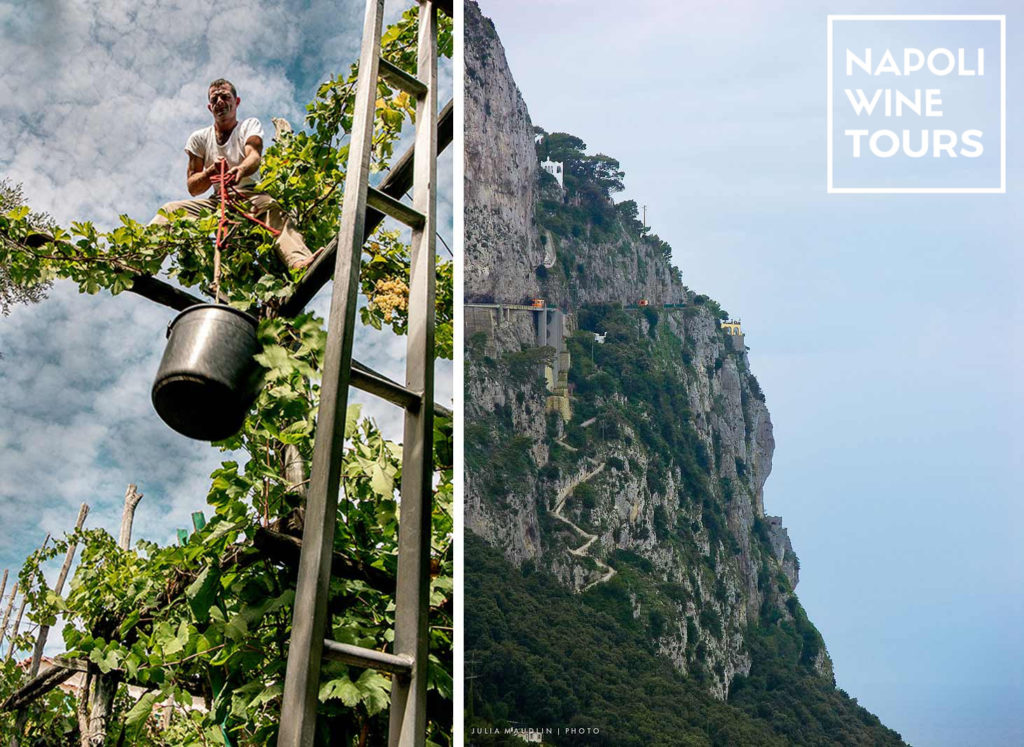
The pearls of the Gulf of Naples: Ischia, Capri and their wines.
Sea, volcanoes, woods, gardens and, above all heroic viticulture represent the characteristics of a landscape that leaves us speechless. Capri and Ischia, the major islands of the Gulf of Naples, (Procida, Vivara and Nisida are the three younger sisters) are well known for their tourist attractions, but not everyone knows that they are excellent wine producing areas. The prevalence of the cultivated varieties are Per’e Palumm ‘(piedirosso), Biancolella and Forastera for the white berried vines, but each island has its own characteristics.
Ischia, the green island, although it shares the volcanic nature of the soil with the Phlegraean Fields, is characterized and differs from the production of the nearby dry land especially for the climate, the grapes and the wine-growing practices. Since the thirteenth century its wines have been appreciated and sold not only in Naples but in Tuscany, Sardinia and even in France. The island, with a great and historic agricultural vocation, witnessed the tourist boom in the 60s of the last century; the hotel industry, catering and “wild” construction have created a new economic engine that takes away men and soil from the vineyards. The vineyard surface has been drastically reduced and production has been affected. It’s not until the new millennium that we witness the rebirth and revaluation of Ischia DOC wine production, especially thanks to some producers who have given it back its prestige. We would like to emphasize that the island’s nickname is not only due to the thick vegetation that covers it, but also to the type of green tuff produced by the eruptions of the Epomeo; the soil on which the vine is grown is, therefore, rich in siliceous, potassium and sodium materials which give the wines a marked flavor and minerality. As another characteristic aspect of Ischia wines, the climate must be considered, thanks to Mount Epomeo, which enjoys a clear difference between the coastal and inland areas where temperatures are lower also due to the presence of vegetation and the height at which they are found. The terraces are located between 200 to 600m above sea level, the grapes grown, almost always on the loose thanks to the volcanic soil, are mainly white: Biancolella and Forastera. Biancolella has a broad aromatic framework, rich in fruit and floral scents, and like Forastera it gives peaks of flavour and minerality capable of making the sip fine and elegant. While piedirosso is the authorized grape variety for the production of the red version.
“Capri, queen of rocks, in your lily and amaranth colored dress I lived to carry out pain and joy, the vineyard of dazzling bunches conquered in the world, the anxious treasure of aroma and hair, zenithal lamp, expanded rose, hive of mine planet. I landed there … “so Pablo Neruda describes the island in 1952. Like him, many have been enchanted by its beauty, first of all Tiberius, who had twelve villas built, up to now considered the glamorous pearl of the Tyrrhenian Sea. But let’s talk about wine: the great difference of this island from the Ischia area is the composition of the land, since Capri is the continuation of the Lattari Mountains, with soils of karst origin and therefore limestone with the only superficial presence of pyroclastic residues. The climate is mild on the whole island without particular differences in areas. Here too the vineyard is raised on terraces overlooking the sea.
As for the Ischia production, the DOC Capri has only recently found its worth on the national scene, but it must be considered that the production is small and that the hectares of vineyards are only about fifteen. The varieties we meet are Falanghina and Greco which in a blend (a part of Biancolella can also be used) make Capri DOC white, while here too Piedirosso is mainly present for the red version.
The tasting of these wines, perhaps in the vineyard on the terraces overlooking the sea, can only remain etched in the memory of us humble mortal “drinkers”.
To follow the itinerary of the wines of the islands of the Gulf of Naples guided by an expert sommelier, do not hesitate to contact us.
